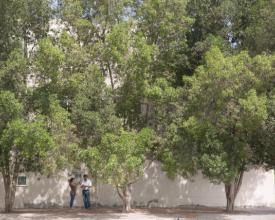
Thermal modeling of urban trees in Abu Dhabi

With summer heat often exceeding 40°C and a population surpassing 1.45 million, Abu Dhabi, the capital of the UAE, faces up to a 2.5°C increase in temperature by 2050. As is the case in most cities, domestic and industrial activities utilise energy to function, generating heat as well as other kinds of pollution. In addition, the high density of large buildings with absorbing surfaces traps and stores heat energy within city streets. Typically, heat stress is addressed using air conditioning to cool indoor spaces. However, air conditioning is extremely energy demanding and cools indoor air by pumping warm air outside thus further exacerbating the problem.
Impacts
For this research, citizen scientists assisted researchers in collecting over 3,000 weather data points, 1,000 tree height measurements and tree locations as well as more than 2,500 infrared images. These collected data points were used in thermal model simulations to identify the most beneficial tree planting and green space configurations for minimising the Urban Heat Island effect in Abu Dhabi’s residential areas.
The results showed that in a low rise Abu Dhabi neighbourhood, planting Poinciana trees 6m apart on pathways and in open areas could reduce air temperatures by up to 0.9° C. This translates to a major reduction of energy use for air conditioning (the largest energy requirement in the UAE) and most importantly, creates better conditions for residents to socialise outside of their home.
Whilst this was the most desirable arrangement for Abu Dhabi specifically, the methodology could be applied to any city. For this, researchers highlight the importance of in-depth knowledge of the location and suitable plant species. Such knowledge can help to reduce costs associated with water consumption, root disruption to infrastructure and other maintenance.




